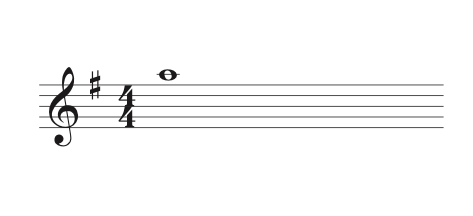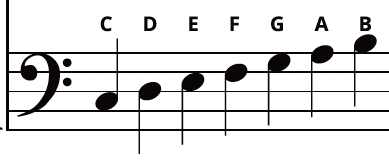This lesson is a sequel. Now I know most sequels aren’t as good as the original (Thanks, Speed 2: Cruise Control), but I’m sure you’ll find this one useful.
To get the most out of it, you should be able to read music on the grand staff. You’ll find the first lesson right here, and if you haven’t watched it yet, I strongly recommend getting comfortable with that first.
Ledger lines are super simple. They are the little lines that go above or below the staff.
Each staff (treble and bass) has 5 lines and 4 spaces. But we know the keyboard has a lot more notes than that, so ledger lines are used to show notes that go beyond the staff.
Here is what a ledger line looks like:

Ledger lines can look scary — but remember they are just an extension of the musical staff. That means all the rules and patterns for reading notes still apply.
Remember your super-great musical alphabet skills? How the musical alphabet goes from A-G before repeating again? Well, that happens here too.
Let’s look at the treble clef as an example. Here are the notes of the treble clef:

And straight away you can see a ledger line — middle C! Because middle C is below the lines and spaces on the treble staff, we need to add a little ledger line for it to sit on.
Middle C is one example of a ledger line, but the more common examples are found ABOVE the treble clef. Let’s take this section of “Minuet in G”:
Looking at the treble clef, we can immediately see a ledger line and a note ABOVE the ledger line. So what does it mean?
Well, we need to remember our musical alphabet. The top line of the clef is an F. So what would the SPACE above the F be?
A G! Now we’ve run out of lines and spaces, so we add that ledger line to keep going up the keyboard.
That little line is the next note up from G, which is an A. And we can see that the note here is the space above that line.
So we know that the note is a B.
In fact, in that entire first measure, all of the notes are above the treble staff, and three of them use ledger lines.
The important thing to remember is that the patterns never change. Moving from a line to a space means you’re moving up ONE note on the keyboard. And the musical alphabet constantly repeats.
Let’s look at the bass clef for a minute now. Here are the notes of the bass clef:

If we keep going DOWN from that low C, the patter would repeat. The line below it is B, then the space is A and the bottom line is G.
And if we keep going beyond the lines on the staff, we get notes that look like this:

That looks like a middle C, right? But remember we’re in the bass clef. So if the bottom line of the bass staff is a G, then the space below it is an F and that note on the ledger line is an E.
Ledger lines above the treble staff and below the bass staff take a little bit of time to learn, but because they follow the same pattern they are not super difficult.
But did you realize you can also have ledger lines in BETWEEN the treble and bass staff? Make sure you watch the lesson where I break it all down.
My biggest piece of advice on how to read ledger lines would be to remember your patterns and try not to get frustrated if things don’t come quickly. Sight-reading is NOT one of my strengths, and it’s something that I still have to work on often.
Happy practicing!
Lisa Witt has been teaching piano for more than 20 years and in that time has helped hundreds of students learn to play the songs they love. Lisa received classical piano training through the Royal Conservatory of Music, but she has since embraced popular music and playing by ear in order to accompany herself and others. Learn more about Lisa.
/marketing/pianote/promos/april/banner-bg-m.webp)
We use cookies for traffic data and advertising. Cookie Policy »
/marketing/pianote/promos/april/banner-title.webp)